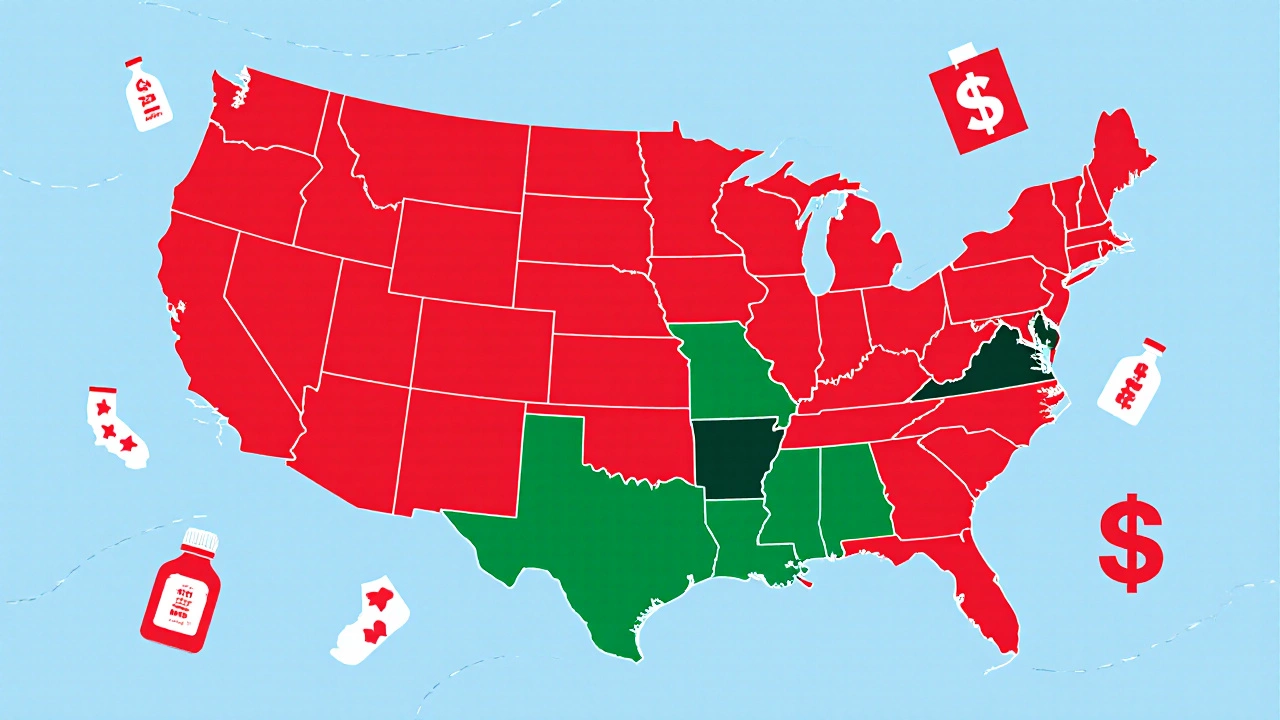IVF Cost Calculator
Estimate Your IVF Costs
Calculate your estimated IVF costs based on your state, insurance coverage, and additional services.
When you’re considering IVF, cost isn’t just a number-it’s the difference between starting a family this year or waiting another two. The price of IVF in the U.S. can swing from under $8,000 to over $25,000 per cycle depending on where you live. So, which state actually offers the most affordable IVF treatment? The answer isn’t what most people assume.
IVF Costs Vary Wildly by State
There’s no national standard for IVF pricing. Unlike countries with universal healthcare, the U.S. treats fertility care like a private market service. That means clinics set their own prices, and insurance coverage varies wildly. In some states, insurers are legally required to cover at least part of IVF. In others, you pay everything out-of-pocket.
Let’s look at real numbers from 2025 clinic data. The average cost of a single IVF cycle without medication in the U.S. is around $14,000. But add in fertility drugs-often $3,000 to $6,000-and you’re looking at $17,000 to $20,000 minimum. In states like New York or California, you might pay $22,000 or more just for the procedure.
The Cheapest State for IVF: Michigan
Michigan consistently ranks as the most affordable state for IVF treatment. Why? A mix of lower overhead costs, competitive clinic markets, and state-level insurance mandates that push prices down.
In Michigan, you can find reputable clinics offering a full IVF cycle-including retrieval, lab work, and transfer-for as low as $8,500. Medications are still extra, but even with drugs, the total often stays under $15,000. That’s nearly $7,000 cheaper than the national average.
Clinics in cities like Ann Arbor, Grand Rapids, and Detroit have been competing for patients for over a decade. Many offer payment plans, discounts for multiple cycles, and even money-back guarantees if treatment fails. That kind of transparency and competition drives prices down.
Why Michigan Is So Affordable
Michigan’s low cost isn’t accidental. In 2019, the state passed a law requiring most insurance plans to cover up to three IVF cycles for eligible patients. That forced clinics to become more efficient and transparent about pricing. Many now publish their fees online-something you rarely see in states without similar laws.
Also, Michigan has fewer high-end fertility centers compared to coastal states. There’s less pressure to offer luxury amenities like private recovery suites or on-site nutritionists. Clinics focus on outcomes, not extras. That keeps costs low without sacrificing success rates.
According to the Society for Assisted Reproductive Technology (SART), Michigan’s average live birth rate per IVF cycle using fresh embryos is 41%-right on par with the national average of 40%. So you’re not trading quality for price.
Other Low-Cost States
Michigan isn’t alone. Several other states offer significantly lower IVF prices:
- Texas: Average cycle cost: $9,500-$12,000. Houston and Dallas have multiple clinics with aggressive pricing. No state mandate, but competition keeps prices down.
- Ohio: $10,000-$13,000. Cincinnati and Columbus clinics often bundle medication discounts.
- Illinois: $11,000-$14,000. State law requires insurance coverage for IVF, which reduces out-of-pocket costs for many patients.
- Georgia: $10,500-$13,500. Atlanta has a growing number of affordable clinics with strong success rates.
These states don’t have the same insurance mandates as Michigan, but they have enough clinics competing for patients that prices stay reasonable.

States to Avoid If Cost Is Your Priority
Some states are expensive for reasons beyond just clinic pricing. Here’s where IVF gets costly:
- California: $18,000-$25,000. High cost of living, high rent for clinics, and low insurance coverage.
- New York: $20,000-$28,000. One of the most expensive states. Insurance coverage is rare unless you have a large employer plan.
- Massachusetts: $17,000-$22,000. State law requires coverage, but many plans have high deductibles and strict eligibility rules.
- Washington D.C.: $19,000-$26,000. Few clinics, high demand, and no state insurance mandate.
In these places, you’re paying for prestige, location, or lack of competition-not better outcomes.
What You’re Really Paying For
Not all IVF clinics are the same. A lower price doesn’t always mean lower quality. But it can mean fewer extras. Here’s what’s typically included in the base price:
- Initial consultation and bloodwork
- Ultrasound monitoring
- Egg retrieval procedure
- Lab fertilization and embryo culture
- Embryo transfer
- Basic pregnancy test
What’s usually not included:
- Fertility medications (can add $3,000-$6,000)
- Genetic testing (PGT-A) - $3,000-$7,000
- Freeze-all cycles - $2,000-$4,000
- Donor eggs or sperm - $15,000-$30,000 extra
- Additional embryo transfers - $3,000-$5,000 each
Some clinics in Michigan and Texas offer all-inclusive packages. For example, a clinic in Lansing, Michigan, offers a $13,900 package that includes meds, monitoring, retrieval, transfer, and one freeze cycle. That’s rare elsewhere.
How to Find the Best Deal
If you’re looking to save money on IVF, here’s how to do it right:
- Use SART’s clinic finder to compare success rates and pricing. Look for clinics that list their fees publicly.
- Ask for a detailed cost breakdown. Don’t accept vague estimates.
- Check if your employer offers fertility benefits-even if you’re not in a state with mandates.
- Consider shared risk or refund programs. Some clinics offer a full or partial refund if you don’t have a baby after a set number of cycles.
- Look into financing options. Many clinics partner with lenders like Fertility Finance or Prosper Healthcare Lending.
One patient from Ohio saved $8,000 by traveling to Michigan for her second cycle. She did her first cycle locally, but the cost was too high. She flew to Ann Arbor, stayed in a rental for two weeks, and saved enough to afford a third cycle. She got pregnant on her third try.

Don’t Just Chase the Lowest Price
IVF is emotional, physical, and financial. Choosing a clinic based only on price can backfire. A clinic that’s $2,000 cheaper might have a 25% success rate instead of 40%. That means two or three failed cycles instead of one successful one.
Look for clinics with:
- Transparency in pricing
- Success rates above 35% for your age group
- Clear communication and support staff
- At least 5 years of experience
Michigan’s top clinics meet all these criteria. So do several in Texas and Ohio. You don’t need to go to a big-city hospital to get great care.
What About Insurance?
Insurance can make a huge difference. States with IVF mandates include: Illinois, Massachusetts, New Jersey, New York, Rhode Island, Connecticut, Maryland, and West Virginia. But even in those states, coverage isn’t automatic.
Check your policy for:
- How many cycles are covered?
- Are you required to try IUI first?
- Is there an age limit?
- Do you need a diagnosis of infertility?
Some plans only cover IVF if you’ve been trying for 2+ years. Others require a specific diagnosis like blocked tubes or low sperm count. Don’t assume you’re covered-call your insurer and ask for the policy in writing.
Final Thoughts
Michigan has the cheapest IVF in the U.S.-not because it’s the best, but because it’s the most competitive and transparent. If you’re budget-conscious, it’s your best bet. But don’t ignore Texas, Ohio, or Georgia. They’re close behind and offer great value.
IVF doesn’t have to be a financial nightmare. With the right research, you can find affordable care without sacrificing your chances. The key is knowing where to look-and asking the right questions before you sign anything.
Is IVF cheaper in other countries than in the U.S.?
Yes, many countries offer IVF at a fraction of U.S. prices. Mexico, India, and the Czech Republic are popular destinations for medical tourism. A full IVF cycle in Mexico can cost $5,000-$7,000, and in India, it’s as low as $3,000. But travel, language barriers, and lack of follow-up care add risks. If you’re considering this route, research clinics thoroughly and ensure they follow international standards like SART or ESHRE guidelines.
Does Medicaid cover IVF?
No, Medicaid does not cover IVF in any state. Even in states with IVF mandates, those laws apply only to private insurance. Medicaid is a state-run program for low-income individuals, and it explicitly excludes fertility treatments. Some states offer limited coverage for diagnostic testing, but not for IVF procedures or medications.
Can I use HSA or FSA to pay for IVF?
Yes. IVF is a qualified medical expense under both Health Savings Accounts (HSA) and Flexible Spending Accounts (FSA). You can use pre-tax dollars from these accounts to pay for the procedure, medications, monitoring, and even travel expenses related to treatment. Keep receipts and documentation in case of an audit.
Are there grants or financial aid for IVF?
Yes. Organizations like the Baby Quest Foundation, Cade Foundation, and Resolve: The National Infertility Association offer grants ranging from $2,500 to $10,000. Applications are competitive and require medical documentation and personal essays. Some clinics also have their own assistance programs for low-income patients. Don’t assume you’re ineligible-apply even if you think you don’t qualify.
How many IVF cycles do most people need?
On average, patients need 2-3 IVF cycles to achieve a live birth. Success rates drop after the third cycle, especially for women over 40. For women under 35, the chance of success after three cycles is about 65-70%. For women over 40, it’s closer to 25-30%. That’s why many people choose clinics with refund programs-they pay more upfront but get a full or partial refund if they don’t have a baby after a set number of tries.

 What is the Most Treatable Mental Illness?
What is the Most Treatable Mental Illness?
 Heart Surgery Pain Explained: What to Expect and How to Manage
Heart Surgery Pain Explained: What to Expect and How to Manage
 How Long to Walk Again Post-Total Knee Replacement
How Long to Walk Again Post-Total Knee Replacement
 Understanding Chemotherapy's Impact on Long-Term Recovery
Understanding Chemotherapy's Impact on Long-Term Recovery
 Essential Advice: Navigating Conversations with Your Pain Management Doctor
Essential Advice: Navigating Conversations with Your Pain Management Doctor